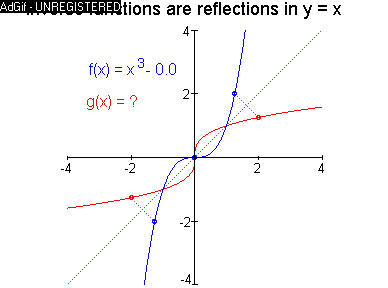|
August 12, 2003 We have modified Frank's Image_and_Cursor applet, converting it to our Image_and_Cursor3Fcns applet, to permit the user to enter up to three different functions, and have also added an Ex.1 button which creates a pop-up window with an exercise. Further, we have modified David Ecks RiemannSums applet, converting it to our ArcLength applet, which now appears on the second (button generated) page in each picture workspace. Check it out: Picturing Functions |

1. Write a Maple worksheet, e.g. InverseFunctions.mws (html version), to experiment with Maple animations, until you have what you want. 2. Extend the worksheet to generate each individual frame of the movie. My procedure: FunctionReflectorMovie, in the worksheet above, has an option (the third argument) to either create a Maple movie or generate the individual frames. So, it does both. 3. Export the worksheet to html. It's best to first remove all images from the worksheet, except the individual movie frames that you want for the animated gif, otherwise your image numbering won't start at the beginning. 4. Use the GIF Construction Set (or another gif animator) to put the images back together, padding with extra images for smooth transitions, and most importantly, setting the frame rate (the one above has a delay of 0.2 secs between frames) for comfortable viewing. Note that if you export the Maple movie, the frame rate is automatically set at a rate that is too fast for comfortable viewing (to see this scroll down in html version), and this is the reason for dealing with the individual images yourself. In addition, here is a Java version using my Java animation player, which has the usual animation controls, e.g. stop, start, forward one, back one, faster, slower. Please feel free to use any of this and let me know if you have questions. John P.S. Here (below) is what you get if you use Advanced Gif Animator (David's demo). Note that in contrast to 4. above, you don't have to work with the individual images. You can just take the exported Maple gif animation itself and directly edit the frame rate. However, if you want a controllable animation, you still have to work with the individual images in order to put them into my Java player.
|
|
July 18, 2003 Our Workshop project is located here: Picturing Functions |
|
July 14, 2003 We have combined the applet below with Frank's Image_and_Cursor applet, using an image of the Lugano Fountain and of the Sion Fountain . We are grateful to Bryan Lewis for making the code for his original Simple Least Squares applet available to be used and modified. We have converted the applet from its original pop-up window to Least Squares Regression (version 1). In addition, we have changed some cosmetic and ergonomic features of its user interface. One of our goals for the workshop is to think about how to write
useful worksheets and quizzes that use the above applet effectively to
develop and assess student learning in statistics.
|
|
Workshop description and homepage: http://www.math.duke.edu/education/prep03/ Pre-Workshop activities and Workshop schedule: http://www.math.duke.edu/education/prep03/schedule.html/
|
|
June Pre-Workshop Activities Downloaded and modified Lite Applets from the JOMA article: 1. Playing with Lite Applets 1: Image and Cursor 2. Playing with Lite Applets 2: Collecting Data 3. Playing with Lite Applets 3: Forms and Javascript If any of this seems useful to other workshop participants, please
feel free to download, use, and modify it for your own purposes. There
are a lot of details to keep track of and glean from the article in order
to get your own working copies to play with. No point in redoing this if
someone else already has it available.
|
|
July Pre-Workshop Activities Checking out some existing regression applets:
|
